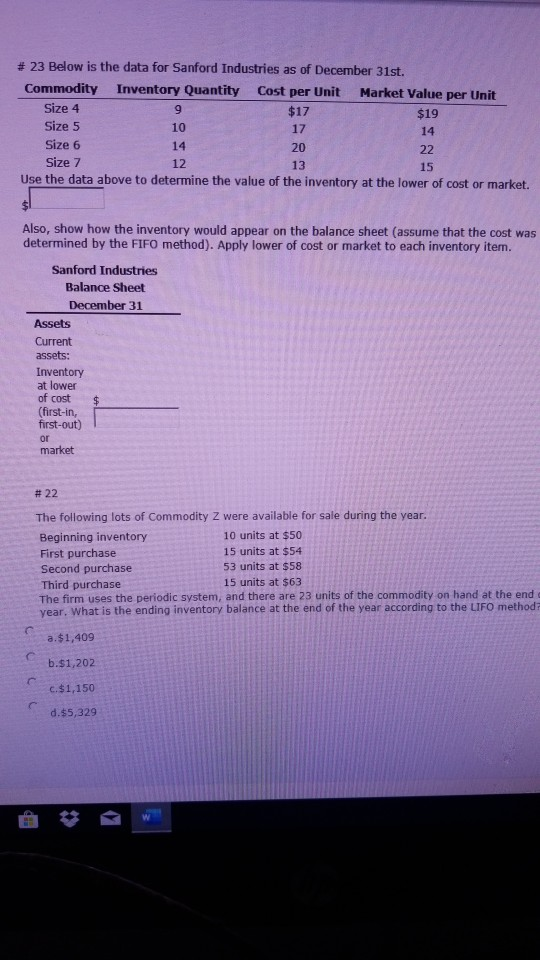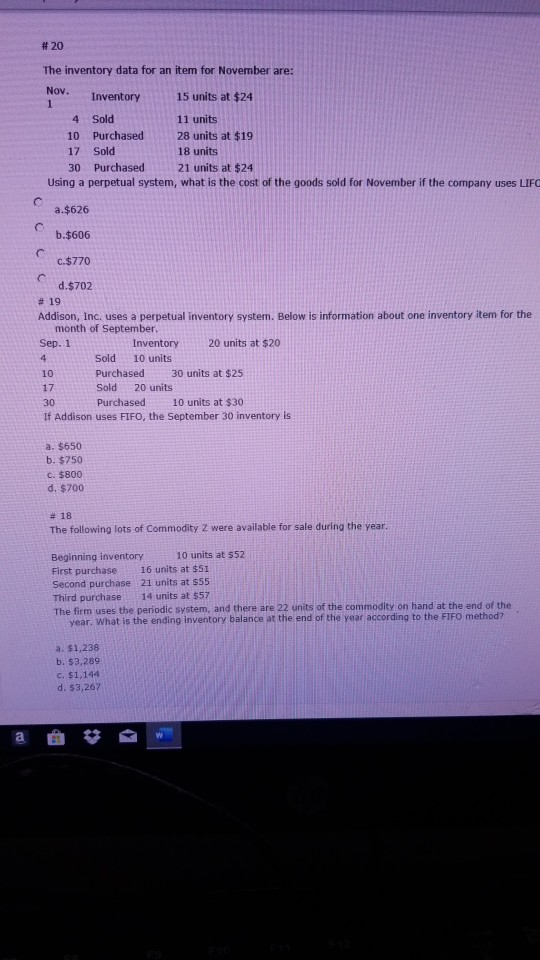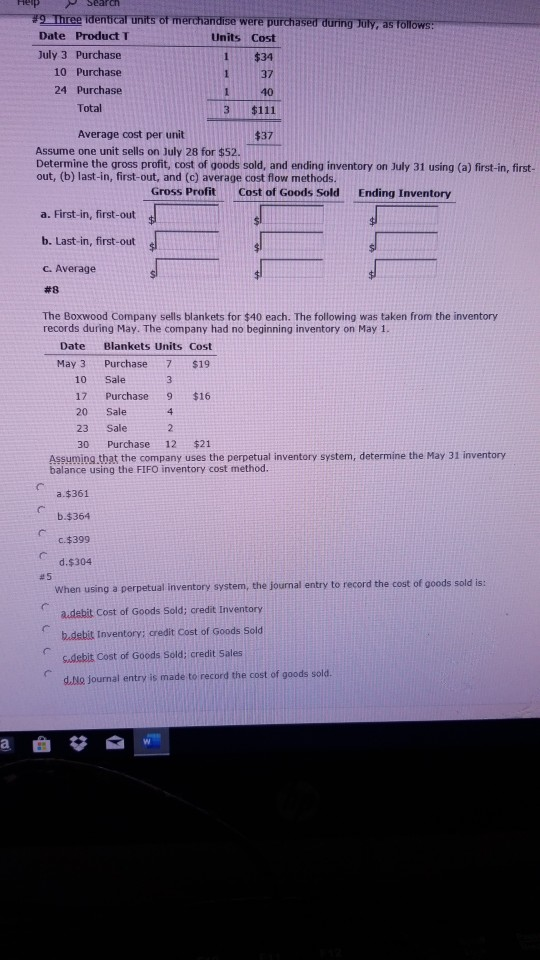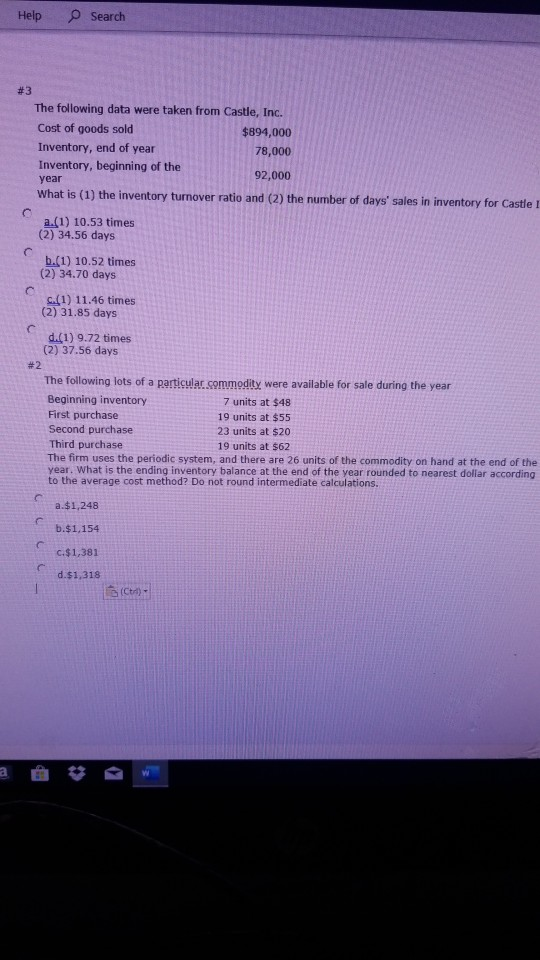Answered step by step
Verified Expert Solution
Question
1 Approved Answer
#23 Below is the data for Sanford Industries as of December 31st. Commodity Inventory Quantity Cost per Unit Market Value per Unit Size 4 9




#23 Below is the data for Sanford Industries as of December 31st. Commodity Inventory Quantity Cost per Unit Market Value per Unit Size 4 9 $17 $19 Size 5 10 17 14 Size 6 14 20 22 Size 7 12 13 15 Use the data above to determine the value of the inventory at the lower of cost or market. Also, show how the inventory would appear determined by the FIFO method). Apply lower of cost or market to each inventory item. the balance sheet (assume that the cost was Sanford Industries Balance Sheet December 31 Assets Current assets: Inventory at lower of cost $ (first-in, first-out) market # 22 The following lots of Commodity Z were available for sale during the year. Beginning inventory First purchase 10 units at $50 15 units at $54 53 units at $58 Second purchase 15 units at $63 Third purchase The firm uses the periodic system, and there are 23 units of the commodity on hand at the end year, What is the ending inventory balance at the end of the year according to the LIFO method? a.$1,409 C b.$1,202 c.$1,150 d.$5,329 #20 The inventory data for an item for November are: Nov. Inventory 15 units at $24 1 4 Sold 11 units 28 units at $19 Purchased 10 Sold 17 18 units Purchased 21 units at $24 30 Using a perpetual system, what is the cost of the goods sold for November if the company uses LIFO a.$626 C b.$606 C c.$770 C d.$702 # 19 Addison, Inc. uses a perpetual inventory system. Below is information about one inventory item for the month of September. 20 units at $20 Sep. 1 Inventory Sold 10 units 4 Purchased 30 units at $25 10 Sold 20 units 17 Purchased 10 units at $30 30 If Addison uses FIFO, the September 30 inventory is a. $650 b. $750 c. $800 d. $700 # 18 The following lots of Commodity Z were available for sale during the year. 10 units at $52 Beginning inventory 16 units at $51 First purchase Second purchase 21 units at $55 Third purchase The firm uses the periodic system, and there are 22 units of the commodity on hand at the end of the vear. What is the ending inventory balance at the end of the year according to the FIFO method? 14 units at $57 a. $1,238 b. $3,289 c. $1.144 d. $3,267 Search #9 Three identical units of merchandise were purchased during July, as follows: Date Product T Units Cost July 3 Purchase 1 $34 10 Purchase 1 37 24 Purchase 40 Total $111 Average cost per unit $37 Assume one unit sells on July 28 for $52. Determine the gross profit, cost of goods sold, and ending inventory on July 31 using (a) first-in, first- out, (b) last-in, first-out, and (c) average cost flow methods. Gross Profit Cost of Goods Sold Ending Inventory a. First-in, first-out $ b. Last-in, first-out $ C. Average #8 The Boxwood Company sells blankets for $40 each. The following was taken from the inventory records during May. The company had no beginning inventory on May 1 Blankets Units Cost Date Purchase May 3 7 $19 Sale 10 3 17 Purchase $16 20 Sale 4 Sale 2 23 Purchase 12 $21 30 Assuming that the company uses the perpetual inventory system, determine the May 31 inventory balance using the FIFO inventory cost method. a.$361 b.$364 C.$399 d.$304 # 5 When using a perpetual inventory system, the journal entry to record the cost of goods sold is: a.debit Cost of Goods Sold: credit Inventory b.debit Inventory: credit Cost of Goods Sold C c.debit Cost of Goods Sold: credit Sales d.No journal entry is made to record the cost of goods sold. Help Search # 3 The following data were taken from Castle, Inc. Cost of goods sold $894,000 Inventory, end of year 78,000 Inventory, beginning of the 92,000 year What is (1) the inventory turnover ratio and (2) the number of days' sales in inventory for Castle I a.(1) 10.53 times (2) 34.56 days b.(1) 10.52 times (2) 34.70 days c(1) 11.46 times (2) 31.85 days C d.(1) 9.72 times (2) 37.56 days # 2 The following lots of a particular commodity were available for sale during the year Beginning inventory First purchase Second purchase 7 units at $48 19 units at $55 23 units at $20 Third purchase The firm uses the periodic system, and there are 26 units of the commodity on hand at the end of the year. What is the ending inventory balance at the end of the year rounded to nearest dollar according to the average cost method? Do not round intermediate calculations. 19 units at $62 a.$1,248 b.$1,154 c.$1,381 d.$1,318 (Ctd) a
Step by Step Solution
There are 3 Steps involved in it
Step: 1

Get Instant Access to Expert-Tailored Solutions
See step-by-step solutions with expert insights and AI powered tools for academic success
Step: 2

Step: 3

Ace Your Homework with AI
Get the answers you need in no time with our AI-driven, step-by-step assistance
Get Started


